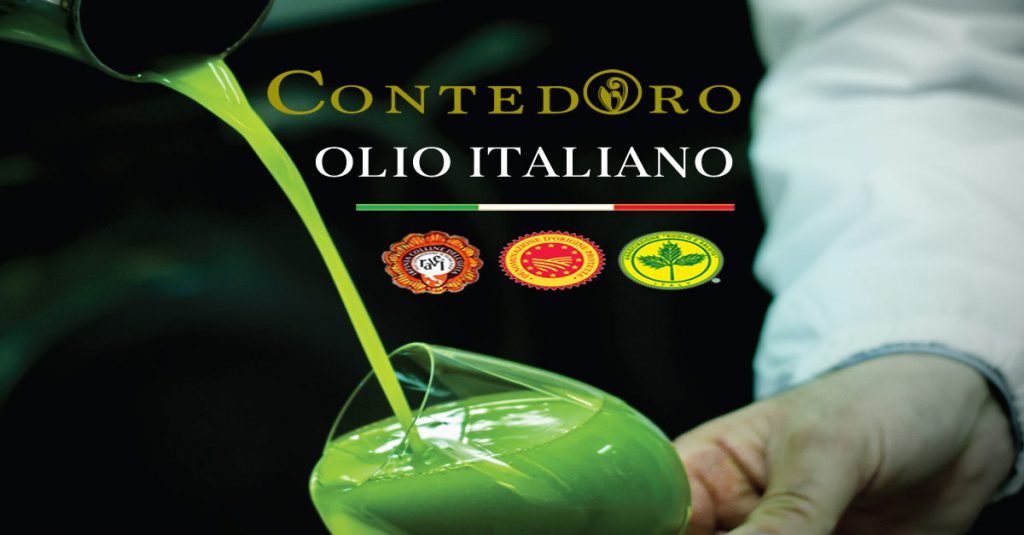NEW OIL.

At this time of year the olives are harvested and the olive presses are set in motion to produce our highly prized extra virgin olive oil. We are in Irpinia where the cultivars leccino, marinese, frantoio, ogliarola and others are grown, giving an oil with a delicate taste perfect for all palates. But then there is she the queen of queens: theolive Ravece that gives a spicy-tasting oil with hints of unripe tomato, freshly mowed grass and an aftertaste of artichoke and almond. Usually the harvesting period begins from mid-October until early December when they have reached their degree of ripeness, i.e., veraison, which turns from green to a purplish color.
Today there are many ways to harvest olives: with shakers, harvesters, etc., but the best way is by hand. The harvested olives need to be placed in large perforated plastic crates that allow air to pass through, and within 24/48h they need to be taken to the mill and pressed. At the mill the olives are defoliated and washed. After that, milling begins with the hammer crusher that crushes the pulp: this is how the olive paste is obtained. Then there is the kneading which consists of separating the oil from the water, it takes place in large steel tanks called gramole and inside they are composed of large paddles that rotate. Finally, the extraction takes place, which separates the oil must from the pomace: here is the new oil with its green color and intoxicating fragrance.

New Oil
We can identify new oil by following some guidelines, namely:
- When to buy it
- Where to buy new oil: the advantage of doing it directly at the mill
- How to recognize new oil
- Why new oil tingles and is bitter
- How much is fair to pay for a liter of new oil
Let us now go on to analyze each of them in detail:
When to buy it
As soon as it is pressed, the oil has a very bitter taste, but after a few months (usually as early as the third) the flavors within it stabilize.
Olive oil enthusiasts and connoisseurs generally prefer the freshly pressed one precisely because of its freshness and lively flavors. For the average consumer, buying and then consuming is recommended from the third month after the olives are pressed, because the oil already begins to lose its “spiciness,” but let’s not forget that bitterness and spiciness within an oil are important as explained in this article.
So we do not associate bitterness and spiciness with a defect. The best time to buy new oil is in early November.
Where to buy new oil: the advantage of doing it directly at the mill
New oil can be purchased directly from the mill to ensure the quality of the product, the processing methods used, and many other important factors.
It can also be purchased online, we recommend the same to inquire about the quality of the product.
Freshly pressed, extra virgin olive oil still has a very strong and sour taste. From the third month after its production, however, new oil releases its unmistakable flavor and unique aroma, which is why connoisseurs prefer this oil, the freshly pressed one.
For the average user, the optimal phase is from the third month after pressing to the following twelve months. After this period has passed, the oil begins to lose the unmistakable “spicy” taste on contact with the palate and the fruity scent of the first period. The nutritional qualities remain intact, but the flavor softens, a sign that the oxidation process has begun – inexorably.
From then on, until two years have passed since its production, despite the loss of the initial aroma, extra virgin oil can still be used as a condiment.
From the third year onward, however, it is preferable to avoid consuming it for food use.
For connoisseurs or those who prefer to smell the scent of freshly pressed oil, the best time to purchase coincides with the time of the first pressing. The best time to purchase is in the period from late October to late November. For those who prefer a sweeter oil, it is advisable to buy new extra virgin oil immediately after the olive harvest period, near December/January.
Ideally, new oil should be bought directly at the mill to ensure a quality batch. The intense taste typical of the first period is already fading from the summer following the olive harvest. This “loss” phenomenon is significantly reduced if the oil is packaged directly at the mill.
How to recognize new oil
The easiest way to recognize an oil is to taste it: the new one has an intense, fruity flavor with bitter and spicy notes. This distinctive taste is due to the non-filtration of the product, which allows its texture to be alive and constantly evolving.
Non-filtration also presents an unmistakable presence of olive pulp particles in the bottle, the real stars of new oil. During the early stages they tend to give a spicy tinge to the product, which, as the months pass, softens, losing its distinctiveness.
If we buyoil at the mill and have the opportunity to taste it or if we buy it and then taste it at home, quality oil will have an unmistakable bitter and spicy taste because of the high number of polyphenols present.
To the taste, quality oil should reveal sensations of bitterness and spiciness. Tingling is not a defect; on the contrary, it precisely indicates thehigh presence in the oil of polyphenols, which are beneficial to the body.
Olive mill oil, in any case, retains more of the natural aromas of the olives, and the result is a fruity, pungent, enveloping taste that is broad and full of personality, compared to commercial oils that have less characterizing and more “flat” tastes and scents.
Be wary of labels that are opaque, have tiny print, and are unclear about the origin of products. Labels must indicate well the brand name, production process, place of production and product characteristics. Food labels must meet 3 basic characteristics: they must be clear, legible and indelible.
With regard to extra virgin olive oil, for example, they must state the product name, sales name, nominal volume and expiration date by which to consume it.
All bottles of extra virgin olive oil bear the words “Superior category olive oil obtained directly from olives and solely by mechanical processes” on the label.
Why new oil tingles and is bitter
New oil has an intense, fruity flavor with bitter and spicy notes. This distinctive taste is due to the non-filtration of the product, which allows its texture to be alive and constantly evolving.
Non-filtration also presents an unmistakable presence of olive pulp particles in the bottle, the real stars of new oil. During the early stages they tend to give a spicy tinge to the product, which, as the months pass, softens, losing its distinctiveness.
If an oil is bitter and spicy, besides being a good salad dressing, it is certainly an important support for our body.
Olive oil is the condiment most recommended by nutritionists because of its high content of monounsaturated fats, especially oleic acid.
Oleic acid, in fact, has the ability to keep bad cholesterol (LDL) in check and good cholesterol (HDL) values unaffected.
The oil is also rich in polyphenols and vitamin E. Polyphenols, as is well known, are excellent antioxidants, essential in the daily fight against free radical formation, to slow cellular aging and strengthen the immune system.
ALSO READ:
Why is olive oil Bitter?
How much is fair to pay for a liter of new oil
One must not be fooled by low-cost offers, always read the label, taste the raw oil, appreciating its aroma and flavor, and making a comparison between a low-cost bottle and a good-quality bottle: you will immediately notice that the typical flavor of the olive and its taste have significant differences.
New oil costs €8-€9 per liter, and in cases of more valuable oils the price may increase. Beware of cheap products: although to the taste it seems like using an extra virgin olive oil, on a health level it does not bring beneficial effects.
If you really want to play it safe, then choose extra virgin olive oil PDO or PGI, which protects and safeguards against counterfeiting throughout Europe.
All PDO or PGI-labeled products must adhere to a specific specification.
The acronym PDO means protected designation of origin and guarantees an oil’s provenance and characteristics. In order for an evo oil to have the PDO mark, it must meet certain criteria, peculiar to each PDO and to each geographical area, related also to the provenance and variety of olives used.
Certified oil undergoes organoleptic checks on the product and the entire supply chain. Buying a PDO extra virgin olive oil means knowing where the olives come from, with the assurance of having a 100% Italian oil. The specifications contain rules regarding the cultivation, harvesting and packaging of the oil and must be strictly adhered to.
If you are in doubt and if the quality of the oil you usually buy at the supermarket does not satisfy you, try going directly to the producers, visiting olive farms and asking to taste the products.

Alfio Lo Conte
Tecnico ed esperto degli oli extravergini di oliva, iscritto nell’Elenco Nazionale sezione Campania.
Maestro di frantoio con diploma, conseguito presso International Extravirgin Agency.
Read more articles by: Alfio Lo Conte
Recent Comments